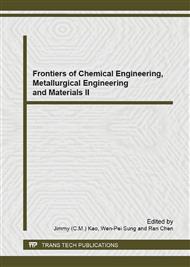[1]
Jha M K, Kumar V, Singh R J. Review of hydrometallurgical recovery of zinc from industrial wastes, J. Resources, Conservation and Recycling. 33(2001)1–22.
DOI: 10.1016/s0921-3449(00)00095-1
Google Scholar
[2]
Fernand Jacques and Joseph Bodson, Process for the elimination of chloride from zinc sulphate solutions , U.S. Patent. 4005174. (1977).
Google Scholar
[3]
Shen Yongqiang, Li Yanhua, Gao Feng, Yan Wenbing. Study on Dechlorine in Zinc Electrolytic Solution with Copper Slag Method, J. Journal of Luoyang Institute of Science and Technology(Natural Science Edition). 21(2011)17-18, 28.
Google Scholar
[4]
Ju Shao-hua, Peng Jin-hui and Zhang Li-bo. A method of microwave roasting process remove chlorine of CuCl residue from Zinc hydrometallurgy, China: 201210095568. 7. (2012).
Google Scholar
[5]
Pickles C.A. Microwaves in extractive metallurgy: Part 2-a review of applications, J. Minerals Engineering. 22(2009)1112-1118.
DOI: 10.1016/j.mineng.2009.02.014
Google Scholar
[6]
Han Mu-xin, Li Dong-mei, Feng Yu-jie. Process optimization of Microwave Drying Sludge with Response surface methodology, J. Advanced Materials Research. 396-398(2012)1269-1272.
DOI: 10.4028/www.scientific.net/amr.396-398.1269
Google Scholar
[7]
Huang He-xun, Chen Han-ping, Hu Zhi-feng. Investigation of microwave-induced Thin-layer Drying for Municipal Sludge, J. Advanced Materials Research. 518-523(2012)3227-3230.
DOI: 10.4028/www.scientific.net/amr.518-523.3227
Google Scholar
[8]
Idris A, Khalid K, Omar W. Drying of silica sludge using microwave heating, J. Applied thermal engineering. 24(2004)905-918.
DOI: 10.1016/j.applthermaleng.2003.10.001
Google Scholar
[9]
Vitanov V. I, Javaid N, Stephenson D. J. Application of response surface methodology for the optimization of micro friction surfacing process, J. Surface & Coatings Technology. 204(2010)3501-3508.
DOI: 10.1016/j.surfcoat.2010.04.011
Google Scholar
[10]
Giri, S. K, Prasad, S. Optimization of microwave-vacuum drying of button mushrooms using response-surface methodology, J. Drying Technology. 25(2007)901–911.
DOI: 10.1080/07373930701370407
Google Scholar
[11]
Körbahti B K, Rauf M A. Determination of optimum operating conditions of carmine decoloration by UV/H2O2 using response surface methodology, J. Journal of hazardous materials. 161(2009) 281-286.
DOI: 10.1016/j.jhazmat.2008.03.118
Google Scholar


